Scottish Schools Adolescent Lifestyle and Substance Use Survey (SALSUS): mental wellbeing report 2018
Mental health and wellbeing findings from the 2018 wave of the Scottish Schools Adolescent Lifestyle and Substance Use Survey (SALSUS).
This document is part of a collection
2 Emotional and behavioural problems and mental wellbeing indicators
Strengths and Difficulties Questionnaire (SDQ) Score
In 2018, 63% of pupils had a normal overall SDQ score, while 18% had a borderline score, and 20% had an abnormal score. For the first time since the SDQ was included in SALSUS, a higher proportion had abnormal scores than had borderline scores (Figure 2.1).
There has been a drop in the proportion of normal overall SDQ scores since 2010, from 73% in 2010 to 69% in 2015, and then to 63% in 2018, (Figure 2.1). The decline in normal scores was largely driven by rising proportions of abnormal scores.
Since 2010, the proportion of pupils with borderline or abnormal scores has continually risen, with an increase in the proportion with a borderline score from 16% in 2015 to 18% in 2018, and an increase in the proportion with an abnormal score from 15% in 2015 to 20% in 2018 (Figure 2.1).
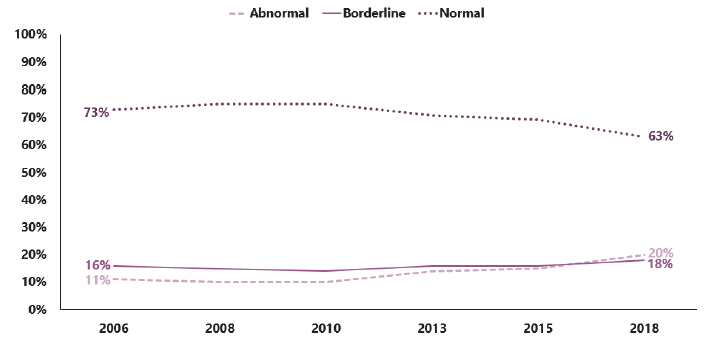
A graph showing trends of overall SDQ scores from 2006 to 2018 among pupils sampled. In this figure, abnormal scores increased from 11% in 2006 to 20% in 2018. Borderline scores rose from 16% in 2006 to 18% in 2018. Normal scores declined from 73% in 2006 to 63% in 2018.
Base: See Appendix A
Pupils of both genders and age groups were more likely to have a borderline or abnormal SDQ score than in previous years. Consistent with previous years' findings, 15 year old girls were still more likely to have a borderline or abnormal score than 15 year old boys or 13 year olds (Figure 2.2). However, the gap between 15 year old girls and the other groups has been reducing since 2013. In particular, the age gap among girls has narrowed.
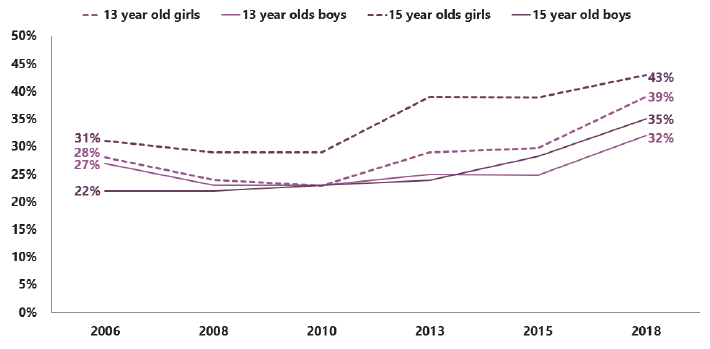
A graph showing increasing trends of the borderline and abnormal SDQ scores between 2006 and 2018 for 13 year old girls and boys, and 15 year old girls and boys. In this figure, these scores for 13 year old girls rose from 28% in 2006 to 39% in 2018, and for 13 year old boys they rose from 27% in 2006 to 32% in 2018. The graph also shows that borderline and abnormal scores for 15 year old girls rose from 31% in 2006 to 43% in 2018, and for 15 year old boys, scores rose from 22% in 2006 to 35% in 2018.
Base: See Appendix A
Individual SDQ Scales
The overall SDQ score gives us a general idea of trends in emotional and behavioural problems among young people in Scotland. It is possible to look in more detail at the four individual scales – hyperactivity, emotional problems, conduct problems and peer problems – to see where changes are happening. (Note that results for the pro-social scale are presented later, in Figure 2.16, as they are quantified in terms of the proportion receiving a normal score).
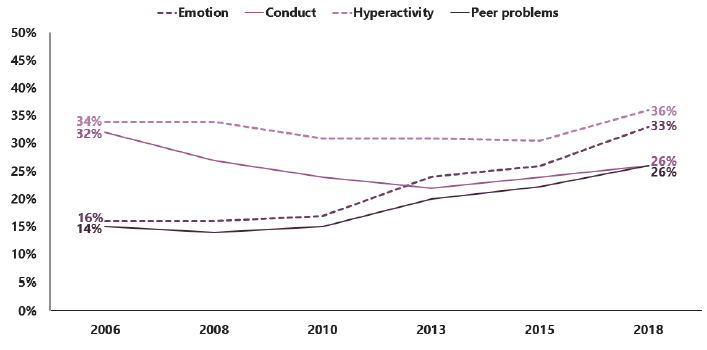
A graph showing the trend of scores of SDQ scales for Emotional problems, Conduct problems, Hyperactivity, and Peer problems between 2006 and 2018. The scores for Emotion scales rose from 16% in 2006 to 33% in 2018. The scores for Conduct problem scales fell from 32% in 2006 to 26% in 2018. The scores for Hyperactivity scales rose from 34% in 2006 to 36% in 2018. The scores for Peer problem scales rose from 14% in 2006 to 26% in 2018.
Base: See Appendix A
In 2018, pupils were most likely to have a borderline or abnormal score on the hyperactivity scale (36%) (Figure 2.3). The next most common issue was emotional problems (33% of pupils had a borderline or abnormal score), which has been rising notably since 2010. Emotional problems was then followed by conduct problems (26% of pupils with a borderline or abnormal score) and peer problems (26% of pupils with a borderline or abnormal score).
There was an increase in the proportion of pupils with a borderline or abnormal score for each of the four scales presented in this section between 2015 and 2018: emotional problems rose from 26% to 33%, hyperactivity rose from 31% to 36%, peer problems rose from 22% to 26%, and conduct problems rose from 24% to 26%.
Emotional Problems
In 2018, 33% of pupils had a borderline or abnormal emotional problems score. This increase, of 9 percentage points since 2015, is the largest of any of the SDQ scales. There was an increase in the proportion with a borderline or abnormal score in the emotional problems score for every age and gender group.
In line with previous years' results, girls were much more likely to have a borderline or abnormal score on the emotional problems scale than boys. Over half of 15 year old girls had a borderline or abnormal emotion SDQ score. Among girls, 15 year old girls were more likely to have borderline or abnormal scores than 13 year old girls, but that gap narrowed between 2015 and 2018 (Figure 2.4).
For both boys and girls, the proportion with a borderline or abnormal emotional problems score has almost doubled between 2010 and 2018 (Figure 2.4).
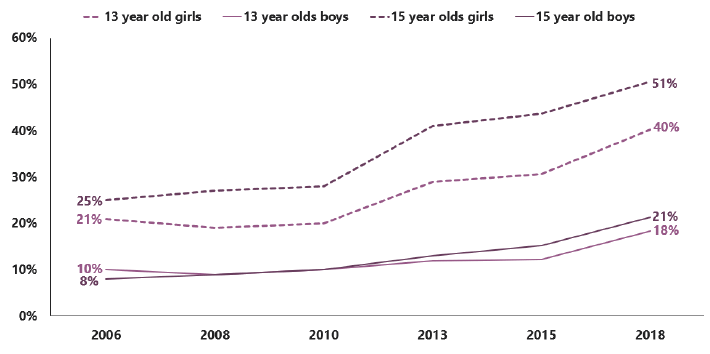
A graph showing trends in increasing overall emotion SDQ scores among 13 year old boys and girls, and 15 year old boys and girls. It shows that borderline emotion scores for 13 year old girls rose from 21% in 2006 to 40% in 2018, and that borderline scores for 13 year old boys rose from 10% in 2006 to 18% in 2018. The graph also shows that abnormal scores for 15 year old girls rose from 25% in 2006 to 51% in 2018, and that abnormal scores for 15 year old boys rose from 8% in 2006 to 21% in 2018.
Base: See Appendix A
Individual items on the emotional problems scale
Looking more closely at the individual items in the emotional problems scale allows for a better understanding of what drives these trends.
The individual statements used to determine the emotional problems score are:
- I worry a lot
- I am nervous in new situations. I easily lose confidence
- I get a lot of headaches, stomach-ache or sickness
- I have many fears, I am easily scared
- I am often unhappy, down-hearted or tearful
For every individual item, girls were most likely than boys to say that the statement was 'certainly true' for them. The items both boys and girls were most likely to say were certainly true were 'I worry a lot' and 'I am nervous in new situations. I easily lose confidence' (Figure 2.5).
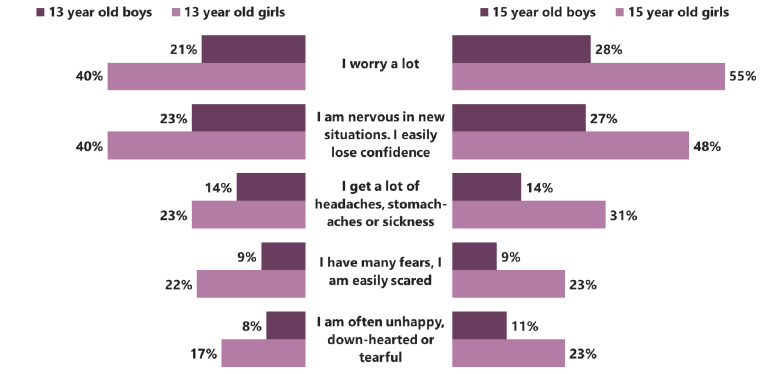
A graph showing the percentage of 13 year old girls and boys, and 15 year girls and boys who reported various emotional problems as ‘certainly true’ for themselves.
The figure shows that the emotional problem item ‘I worry a lot’ was reported as ‘certainly true’ for 40% of 13 year old girls, 21% of 13 year old boys, 55% of 15 year girls, and 28% of 15 year old boys.
The figure shows that the emotional problem item ‘I am nervous in new situations. I easily lose confidence’ was reported as ‘certainly true’ for 40% of 13 year old girls, 23% of 13 year old boys, 48% of 15 year girls, and 27% of 15 year old boys.
The figure shows that the emotional problem item ‘I get a lot of headaches, stomach-aches or sickness’ was reported as ‘certainly true’ for 23% of 13 year old girls, 14% of 13 year old boys, 31% of 15 year girls, and 14% of 15 year old boys.
The figure shows that for the emotional problem item ‘I have many fears, I am easily scared’ was reported as ‘certainly true’ for 23% of 13 year old girls, 14% of 13 year old boys, 31% of 15 year girls, and 14% of 15 year old boys.
The figure shows that for the emotional problem item ‘I am often unhappy, down-hearted or tearful.’ was reported as ‘certainly true’ for 17% of 13 year old girls, 8% of 13 year old boys, 23% of 15 year girls, and 11% of 15 year old boys.
Base: See Appendix A
Hyperactivity
In 2018, 36% of pupils had a borderline or abnormal hyperactivity score. This makes hyperactivity the scale with the lowest proportion of 'normal' scores, in line with previous years. For every group, there has been an increase in the proportion of pupils with a borderline or abnormal score since 2015 (Figure 2.6). Borderline or abnormal hyperactivity scores were most common among 15 year old girls, as in previous years, but the gap between 15 year old girls and the other groups has narrowed.
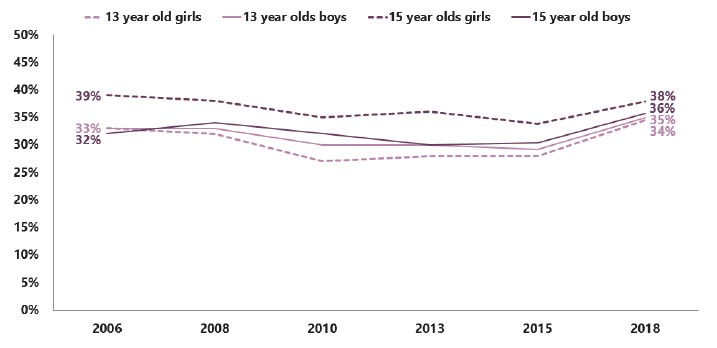
A graph showing trends in abnormal or borderline hyperactivity SDQ scores among 13 year old boys and girls, and 15 year old boys and girls. It shows that borderline or abnormal hyperactivity scores for 13 year old girls rose from 33% in 2006 to 34% in 2018, and for 13 year old boys these scores rose from 33% in 2006 to 35% in 2018. The graph also shows that borderline or abnormal scores for 15 year old girls fell from 39% in 2006 to 38% in 2018, and that scores for 15 year old boys rose from 32% in 2006 to 36% in 2018.
Base: See Appendix A
Individual items on the hyperactivity scale
The individual statements used to determine the hyperactivity score are:
- I am restless, I cannot stay still for long
- I am constantly fidgeting or squirming
- I am easily distracted. I find it difficult to concentrate
- I think before I do things
- I finish the work I am doing. My attention is good
There were no clear age or gender patterns across the hyperactivity items. The biggest difference was that 15 year olds girls were more likely to say that they were easily distracted than 15 year old boys (Figure 2.7).
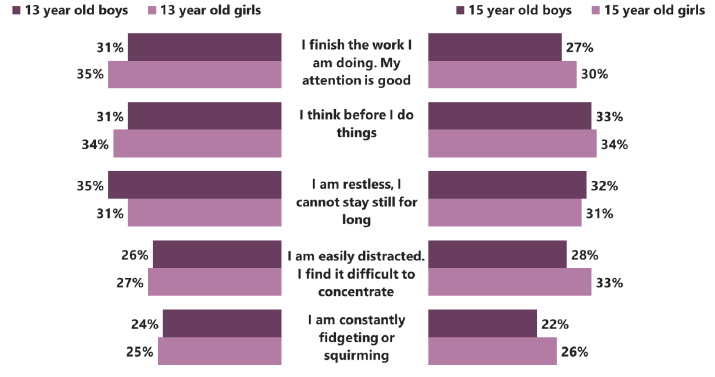
A graph showing the percentage of 13 year old girls and boys, and 15 year girls and boys who reported various hyperactivity problems as ‘certainly true’ for themselves in 2018.
The figure shows that for the hyperactivity problem item ‘I finish the work I am doing. My attention is good’ was reported as ‘certainly true’ for 35% of 13 year old girls, 31% of 13 year old boys, 30% of 15 year girls, and 27% of 15 year old boys.
The figure shows that for the hyperactivity problem item ‘I think before I do things’ was reported as ‘certainly true’ for 34% of 13 year old girls, 31% of 13 year old boys, 34% of 15 year girls, and 33% of 15 year old boys.
The figure shows that for the hyperactivity problem item ‘I am restless, I cannot stay still for long’ was reported as ‘certainly true’ for 31% of 13 year old girls, 35% of 13 year old boys, 31% of 15 year girls, and 32% of 15 year old boys.
The figure shows that for the hyperactivity problem item ‘I am easily distracted. I find it difficult to concentrate’ was reported as ‘certainly true’ for 27% of 13 year old girls, 26% of 13 year old boys, 33% of 15 year girls, and 28% of 15 year old boys.
The figure shows that for the hyperactivity problem item ‘I am constantly fidgeting or squirming’ was reported as ‘certainly true’ for 25% of 13 year old girls, 24% of 13 year old boys, 26% of 15 year girls, and 22% of 15 year old boys.
Base: See Appendix A
Peer problems
In 2018, 26% of pupils had a borderline or abnormal peer problems score, making peer problems the scale with the lowest proportion of borderline or abnormal scores, in line with previous years.
Boys were more likely than girls to have a borderline or abnormal peer problems score (Figure 2.8), as found in previous years. Between 2015 and 2018, this gap has widened for 15 year old boys but not for 13 year old boys.
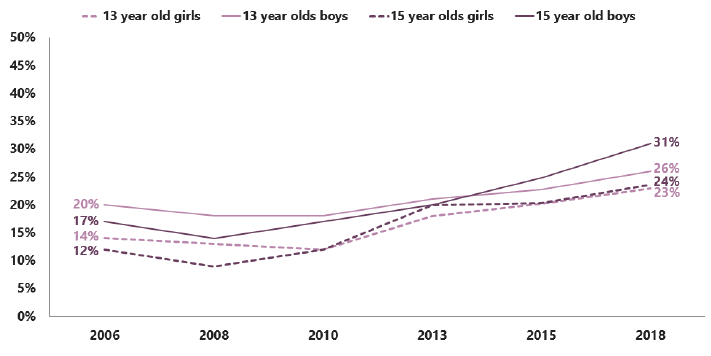
A graph showing trends in abnormal or borderline SDQ scores among 13 year old boys and girls, and 15 year old boys and girls. It shows that borderline or abnormal peer problem scores for 13 year old girls rose from 14% in 2006 to 23% in 2018, and for 13 year old boys these scores rose from 20% in 2006 to 26% in 2018. The graph also shows that borderline or abnormal scores for 15 year old girls rose from 12% in 2006 to 24% in 2018, and that these scores for 15 year old boys rose from 17% in 2006 to 31% in 2018.
Base: See Appendix A
Individual items on the peer problems scale
The individual statements included in the peer problems scale are:
- I have one good friend or more
- Other people my age generally like me
- I get on better with adults than with people my own age
- I am usually on my own. I generally play alone or keep to myself
- Other children or young people pick on me or bully me
The items that seem to distinguish 15 year old boys from the other groups are 'I have one good friend or more' and 'I am usually on my own. I generally play alone or keep to myself' (Figure 2.9). This could suggest that 15 year old boys are more likely to be socially isolated than the other groups.
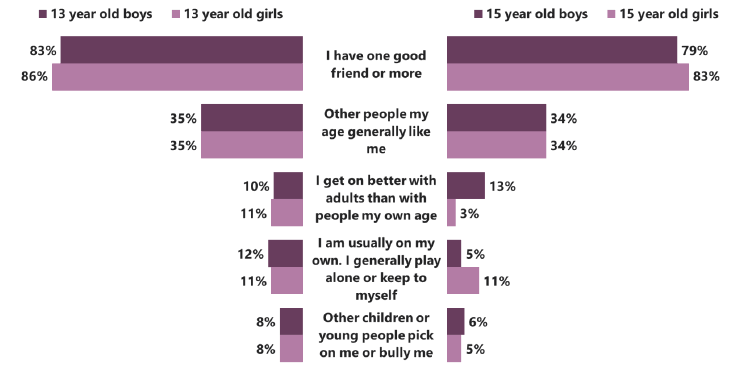
A graph showing the percentage of 13 year old girls and boys, and 15 year girls and boys who reported various items in peer problems scale as ‘certainly true’ for themselves in 2018.
The figure shows that for the peer problem item: ‘I have one good friend or more’ was reported as ‘certainly true’ for 86% of 13 year old girls, 83% of 13 year old boys, 83% of 15 year girls, and 79% of 15 year old boys.
The figure shows that for the peer problem item ‘Other people my age generally like me’ was reported as ‘certainly true’ for 35% of 13 year old girls, 35% of 13 year old boys, 34% of 15 year girls, and 34% of 15 year old boys.
The figure shows that for the peer problem item ‘I get on better with adults than with people my own age’ was reported as ‘certainly true’ for 11% of 13 year old girls, 10% of 13 year old boys, 3% of 15 year girls, and 13% of 15 year old boys.
The figure shows that for the peer problem item ‘I am usually on my own. I generally play alone or keep to myself’ was reported as ‘certainly true’ for 11% of 13 year old girls, 12% of 13 year old boys, 11% of 15 year girls, and 5% of 15 year old boys.
The figure shows that for the peer problem item ‘Other children or young people pick on me or bully me’ was reported as ‘certainly true’ for 8% of 13 year old girls, 8% of 13 year old boys, 5% of 15 year girls, and 6% of 15 year old boys.
Base: See Appendix A
Conduct problems
26% of pupils had a borderline or abnormal SDQ score in the conduct problems scale. In line with previous years, borderline or abnormal conduct problem scores were more common among boys than among girls.
For 15 year old girls and boys, there were no changes between 2015 and 2018 in the proportion with borderline or abnormal scores (Figure 2.10). For both 13 year old girls and 13 year old boys, there was a small increase in the proportion with borderline or abnormal scores in the conduct problems scale.
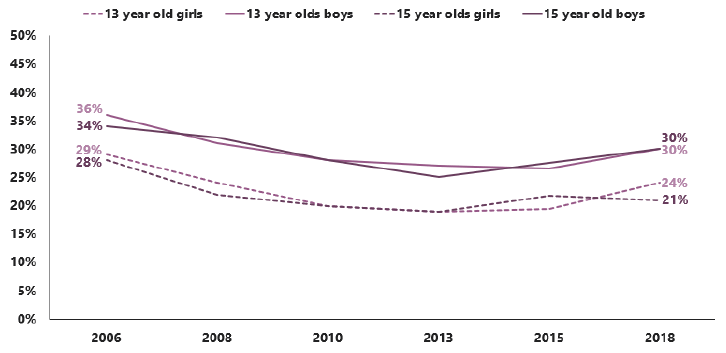
A graph showing trends in abnormal or borderline conduct problems SDQ scores among 13 year old boys and girls, and 15 year old boys and girls. It shows that borderline or abnormal conduct problem scores for 13 year old girls fell from 29% in 2006 to 24% in 2018, and for 13 year old boys these scores fell from 36% in 2006 to 30% in 2018. The graph also shows that borderline or abnormal scores for 15 year old girls fell from 28% in 2006 to 21% in 2018, and that abnormal scores for 15 year old boys fell from 34% in 2006 to 30% in 2018.
Base: See Appendix A
Individual items on the conduct problems scale
Individual items on the conduct problems scale are as follows:
- I usually do as I am told
- I get very angry and often lose my temper
- I am often accused of lying or cheating
- I take things that are not mine from home, school or elsewhere
- I fight a lot. I can make other people do what I want
The issues which seem to be driving the gender difference in the overall conduct score are that girls (particularly 15 year old girls) are more likely to do what they are told, and boys are more likely to say that they are often accused of lying or cheating (particularly 15 year old boys) (Figure 2.11).
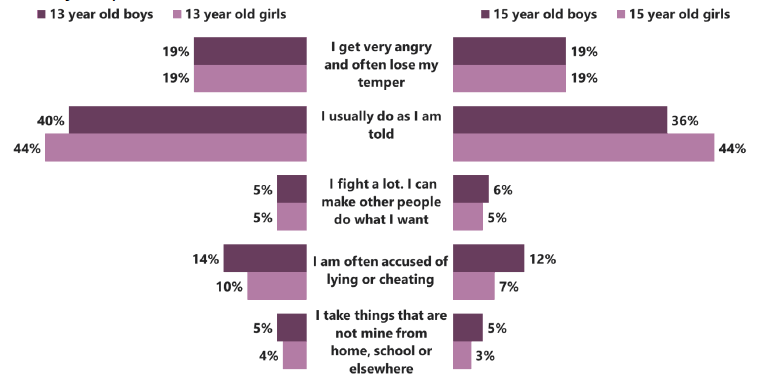
A graph showing the percentage of 13 year old girls and boys, and 15 year girls and boys who reported various conduct problems as ‘certainly true’ for themselves in 2018.
The figure shows that the peer problem item ‘I get very angry and often lose my temper’ was reported as ‘certainly true’ for 19% of 13 year old girls, 19% of 13 year old boys, 19% of 15 year girls, and 19% of 15 year old boys.
The figure shows that the peer problem item ‘I usually do as I am told’ was reported as ‘certainly true’ for 44% of 13 year old girls, 40% of 13 year old boys, 44% of 15 year girls, and 36% of 15 year old boys.
The figure shows that the peer problem item ‘I fight a lot. I can make other people do what I want’ was reported as ‘certainly true’ for 5% of 13 year old girls, 5% of 13 year old boys, 5% of 15 year girls, and 6% of 15 year old boys.
The figure shows that the peer problem item ‘I am often accused of lying or cheating’ was reported as ‘certainly true’ for 10% of 13 year old girls, 14% of 13 year old boys, 7% of 15 year girls, and 12% of 15 year old boys.
The figure shows that the peer problem item ‘I take things that are not mine from home, school or elsewhere’ was reported as ‘certainly true’ for 4% of 13 year old girls, 5% of 13 year old boys, 3% of 15 year girls, and 5% of 15 year old boys.
Base: See Appendix A
Pro-social score
As in previous years, girls were more likely to have a 'normal' pro-social score than boys (Figure 2.12). There has been very little change since 2015 in pro-social score.
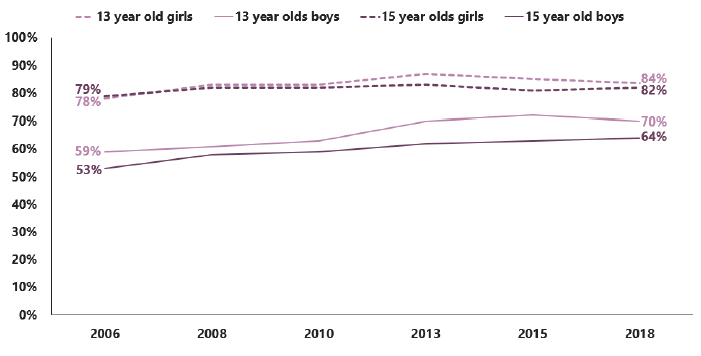
A graph showing trends in normal pro-social SDQ scores among 13 year old girls and boys, and 15 year old girls and boys between 2006 and 2018. It shows that normal pro-social SDQ scores for 13 year old girls rose from 78% in 2006 to 84% in 2018, and for 13 year old boys these scores rose from 59% in 2006 to 70% in 2018. The graph also shows that for 15 year old girls these scores rose from 79% in 2006 to 82% in 2018, and that they rose from 53% in 2006 to 64% in 2018 for 15 year old boys.
Base: See Appendix A
Individual items on the pro-social scale are as follows:
- I try to be nice to other people. I care about their feelings
- I usually share with others (food, games, pens etc.)
- I am helpful if someone is hurt, upset or feeling ill
- I am kind to younger children
- I often volunteer to help others (parents, teachers, children)
Across all items on the pro-social scale, girls were much more likely than boys to say that they were 'certainly true' (Figure 2.13).
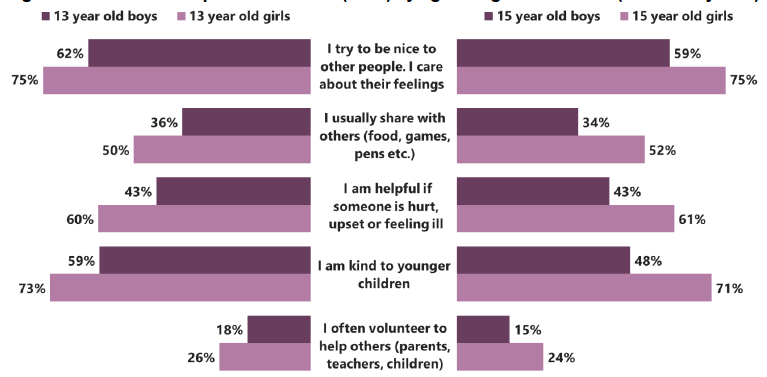
A graph showing the percentage of 13 year old girls and boys, and 15 year girls and boys who reported various pro-social items as ‘certainly true’ for themselves in 2018.
The figure shows that the pro-social item ‘I try to be nice to other people. I care about their feelings’ was reported as ‘certainly true’ for 75% of 13 year old girls, 62% of 13 year old boys, 75% of 15 year girls, and 59% of 15 year old boys.
The figure shows that the pro-social item ‘I usually share with others (food, games, pens etc.)’ for 50% of 13 year old girls, 36% of 13 year old boys, 52% of 15 year girls, and 34% of 15 year old boys.
The figure shows that the pro-social item ‘I am helpful if someone is hurt, upset or feeling ill’ was reported as ‘certainly true’ for 60% of 13 year old girls, 43% of 13 year old boys, 61% of 15 year girls, and 43% of 15 year old boys.
The figure shows that the pro-social item ‘I am kind to younger children’ was reported as ‘certainly true’ for 73% of 13 year old girls, 59% of 13 year old boys, 71% of 15 year girls, and 48% of 15 year old boys.
The figure shows that the pro-social item ‘I often volunteer to help others (parents, teachers, children)’ was reported as ‘certainly true’ for 26% of 13 year old girls, 18% of 13 year old boys, 24% of 15 year girls, and 15% of 15 year old boys.
Base: See Appendix A
WEMWBS
While the SDQ score tells us about emotional and behavioural problems, WEMWBS measures mental wellbeing. For example, it considers how clear-headed, optimistic and positive the pupil is feeling. In the WEMWBS scale, the lowest possible score (indicating poor mental wellbeing) is 14 and the highest possible score is 70 (indicating good mental wellbeing).
The average[11] WEMWBS score for all pupils decreased between 2015 and 2018 from 48.4 to 46.9. This suggests that there has been a negative shift in mental wellbeing among 13 and 15 year olds since the last survey.
The average WEMWBS score has decreased for all groups between 2015 and 2018. However, the greatest change has been among 13 year old girls (from 48.2 in 2015 to 46.3 in 2018) and 15 year old boys (from 50.1 to 48.3) (Figure 2.14).
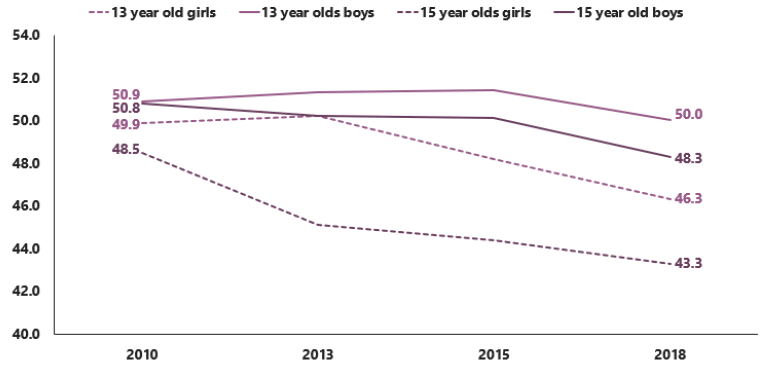
A graph showing downward trends in the mean WEMWBS scores of 13 year old girls and boys, and 15 year old girls and boys between 2010 and 2018.
The figure shows that the mean score for 13 year old girls was 46.3 in 2018, a drop from 49.9 in 2010.
It also shows that the mean score for 13 year old boys was 50.0 in 2018, a drop from 50.9 in 2010.
Further, the figure shows that the mean score for 15 year old girls was 43.3 in 2018, a drop from 48.5 in 2010, and that the mean score for 15 year old boys was 48.3, a drop from 50.8 in 2010.
Base: See Appendix A
The WEMWBS scale consists of the following statements:
- I've been feeling optimistic about the future
- I've been feeling useful
- I've been feeling relaxed
- I've been feeling interested in other people
- I've had energy to spare
- I've been dealing with problems well
- I've been thinking clearly
- I've been feeling good about myself
- I've been feeling close to other people
- I've been feeling confident
- I've been able to make up my own mind about things
- I've been feeling loved
- I've been interested in new things
- I've been feeling cheerful
A majority of pupils reported often feeling loved (69%), being able to make up their own mind (64%) and feeling close to other people (57%). Around half said they often felt cheerful (51%) and interested in new things (51%), whereas the less than half identified with the rest of the statements often or all of the time (Figure 2.15).
The proportion of pupils who felt these statements applied to them 'often' or 'all of the time' was typically lower among 15 year olds compared to 13 year olds and tended to be lower among girls compared to boys (Figure 2.15).
Gender differences were more prominent among 15 year olds than 13 year olds, where girls were less likely to report positive wellbeing on every individual measure. 15 year old boys were more than twice as likely than 15 year old girls to report having been feeling good about themselves and to have been feeling relaxed (53% compared to 26% and 45% compared to 21% respectively). There were similarly large gaps in reports for having energy to spare (46% compared to 25%), as well as for feeling confident (51% compared to 27%), which also saw the largest gender gap among 13 year olds (Figure 2.15).
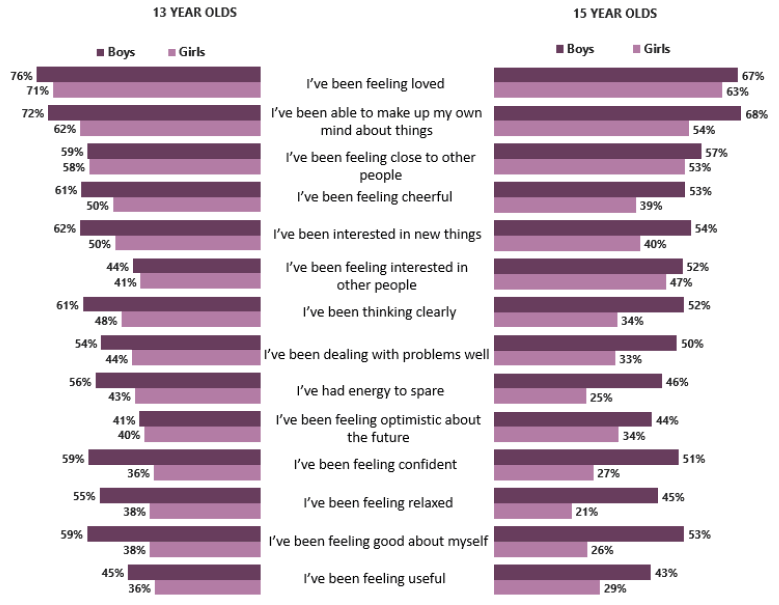
The graph shows the proportion of pupils who report the measures ‘often’ or ‘all of the time’ in relation to various statements of the WEMWBS scale,
The figure shows that reports of ‘often’ or ‘all of the time’ in relation to the statement ‘I’ve been feeling loved’ were made by 71% of 13 year old girls, 76% of 13 year old boys, 63% of 15 year old girls, and 67% of 15 year old boys.
The figure shows that reports of ‘often’ or ‘all of the time’ in relation to the statement ‘I’ve been able to make up my own mind about thing’ were made by 62% of 13 year old girls, 72% of 13 year old boys, 54% of 15 year old girls, and 68% of 15 year old boys.
The figure shows that reports of ‘often’ or ‘all of the time’ in relation to the statement ‘I’ve been feeling close to other people’ were made by 58% of 13 year old girls, 59% of 13 year old boys, 53% of 15 year old girls, and 57% of 15 year old boys.
The figure shows that reports of ‘often’ or ‘all of the time’ in relation to the statement ‘I’ve been feeling cheerful’ were made by 50% of 13 year old girls, 61% of 13 year old boys, 39% of 15 year old girls, and 53% of 15 year old boys.
The figure shows that reports of ‘often’ or ‘all of the time’ in relation to the statement ‘I’ve been interested in new things’ were made by 50% of 13 year old girls, 62% of 13 year old boys, 40% of 15 year old girls, and 54% of 15 year old boys.
The figure shows that reports of ‘often’ or ‘all of the time’ in relation to the statement ‘I’ve been feeling interested in other people’ were made by 41% of 13 year old girls, 44% of 13 year old boys, 47% of 15 year old girls, and 52% of 15 year old boys.
The figure shows that reports of ‘often’ or ‘all of the time’ in relation to the statement ‘I’ve been thinking clearly’ were made by 48% of 13 year old girls, 61% of 13 year old boys, 34% of 15 year old girls, and 52% of 15 year old boys.
The figure shows that reports of ‘often’ or ‘all of the time’ in relation to the statement ‘I’ve been dealing with problems well’ were made by 44% of 13 year old girls, 54% of 13 year old boys, 33% of 15 year old girls, and 50% of 15 year old boys.
The figure shows that reports of ‘often’ or ‘all of the time’ in relation to the statement ‘I’ve had energy to spare’ were made by 43% of 13 year old girls, 56% of 13 year old boys, 25% of 15 year old girls, and 46% of 15 year old boys.
The figure shows that reports of ‘often’ or ‘all of the time’ in relation to the statement ‘I’ve been feeling optimistic about the future’ were made by 40% of 13 year old girls, 41% of 13 year old boys, 34% of 15 year old girls, and 44% of 15 year old boys.
The figure shows that reports of ‘often’ or ‘all of the time’ in relation to the statement ‘I’ve been feeling confident’ were made by 36% of 13 year old girls, 59% of 13 year old boys, 27% of 15 year old girls, and 51% of 15 year old boys.
The figure shows that reports of ‘often’ or ‘all of the time’ in relation to the statement ‘I’ve been feeling relaxed’ were made by 38% of 13 year old girls, 55% of 13 year old boys, 21% of 15 year old girls, and 45% of 15 year old boys.
The figure shows that reports of ‘often’ or ‘all of the time’ in relation to the statement ‘I’ve been feeling good about myself’ were made by 38% of 13 year old girls, 59% of 13 year old boys, 26% of 15 year old girls, and 53% of 15 year old boys.
The figure shows that reports of ‘often’ or ‘all of the time’ in relation to the statement ‘I’ve been feeling useful’ were made by 36% of 13 year old girls, 45% of 13 year old boys, 29% of 15 year old girls, and 43% of 15 year old boys.
Base: See Appendix A
Contact
Email: salsus@gov.scot
There is a problem
Thanks for your feedback